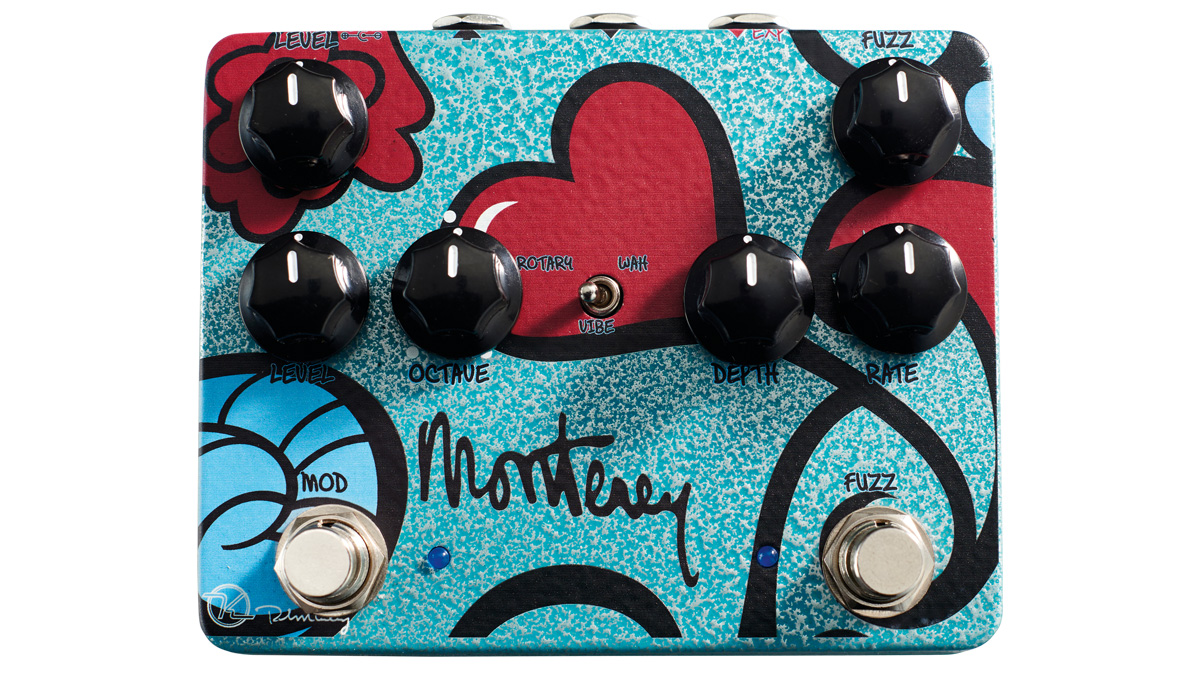MusicRadar Verdict
This is not such a slavish copy of the maestro's gear, but the spirit is certainly there.
Pros
- +
Large sound variation in a compact pedal; Hendrix-esque tones; independent switching for fuzz and modulation.
Cons
- -
A tone knob for the fuzz sound would have been nice, but it's not an essential addition.
MusicRadar's got your back
Setting fire to his Stratocaster at the Monterey Pop festival in 1967 was a masterstroke of showmanship from Hendrix, one of rock's most iconic moments in history.
Almost 50 years later, Keeley has released a new pedal named after the Californian event that helped expose Jimi and his playing to a worldwide audience.
With sounds and artwork inspired by the man and his Monterey Strat, the pedal is part of Keeley's Workstation series and offers independent fuzz and modulation sections in a single stompbox. Let's plug in...
Sounds
The Monterey features two independent footswitches: one for the fuzz, the other for modulation. An internal switch sets the effect order so you can run the modulation before or after the fuzz.
The silicon transistor-based fuzz has Level and Fuzz knobs and is a useful vintage-style fuzz-for-all-seasons, nicely touch-sensitive and serves up a bright edge that cuts through while still offering plenty of girth. The Fuzz knob takes a bit of travel for satisfying results, but is at its best in its upper reaches for a smooth singing tone.
You have a choice of three modulation effects - rotary, vibe or wah - that can be selected by a small three-way switch. Four knobs (Level, Octave, Depth, Rate) adjust the effect, but, Level knob aside, each can have a different function specific to the modulation type.
"This is a pedal with a wealth of sounds waiting to be discovered."
The wah is very versatile in that you can effectively get four different effects. With the Depth knob at minimum, you get something of a 'cocked' wah tone, the boosted tone (equivalent to the actual position where a physical wah's treadle would be parked) being set by the Rate knob, which adjusts the frequency.
Want all the hottest music and gear news, reviews, deals, features and more, direct to your inbox? Sign up here.
If you plug in an expression pedal in this mode, it takes over from the Rate knob and you can sweep the frequencies, giving you the functionality of a traditional wah pedal. Nudge up the Depth knob for an auto wah effect that responds dynamically to pick attack and, combined with fuzz and some octave, offers funky envelope filter sounds.
Incidentally, you can add in a pitch-shifted octave effect with all of the wah (and the Vibe) sounds. At the central position of the Octave knob, there's no octave added, but to the left you get increasing amounts of lower octave, with upper octave to the right.
It all tracks extremely well, offering the likes of guitar/bass unison riffing or a tickle of upper harmonic ear candy for your fuzz. Getting back to the wah, though, the real surprise is with the depth knob past the 12 o'clock point where you get what Keeley calls "Harmonic Wah" that's more tremolo than wah, and a very close relation to the sort of gorgeous harmonic tremolo found on vintage Fender 'brownface' amps.
The Vibe effect here may not use the optical circuitry of an original Uni-Vibe, but it gives a really accurate reproduction of the sound and you can use an expression pedal to control the speed, vintage-style.
Used in conjunction with fuzz, it's phase-y, liquid Hendrix tone right there and not a million miles away from Ernie Isley. Another bonus in Vibe mode is that if you turn the Depth knob right down, you can just use the Octave effect on its own or with the fuzz.
The Rotary setting gives you a tasty approximation of a rotary speaker, with Depth and Rate knobs setting the basic effect or an expression pedal controlling the rate. The Octave knob places the emphasis towards the upper horn or lower drum of the simulated cabinet, giving you brighter or more subdued tonal options. Also, at minimum depth you get a cab with no rotation, so can use the facility as a footswitchable tonal shift.
Overall, this is a pedal with a wealth of sounds waiting to be discovered. It may be worth the price of admission for the modulation effects alone, but with fuzz, it's brilliantly versatile, offering a spectrum of tonal combinations and switching practicality.
There have been 'Jimi-in-a-box' pedals before, such as the Foxrox Captain Coconut, which put accurate emulations of Fuzz Face, Uni-Vibe and Octavia in a single unit, you just needed to add a wah.
If you like Hendrix sounds, you'll be able to dial in something close, but if that's not your focus, just think of this as a practical array of timeless effects put together in a form that's perfect for today's pedalboards. We like the idea that this could be the basis of a minimal pedalboard - one of these plus a delay in front of a decent amp and you could be sorted.
Trevor Curwen has played guitar for several decades – he's also mimed it on the UK's Top of the Pops. Much of his working life, though, has been spent behind the mixing desk, during which time he has built up a solid collection of the guitars, amps and pedals needed to cover just about any studio session. He writes pedal reviews for Guitarist and has contributed to Total Guitar, MusicRadar and Future Music among others.

